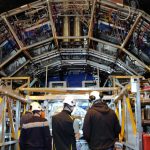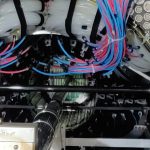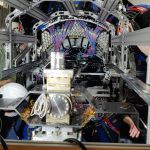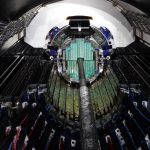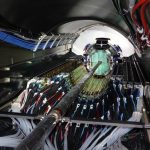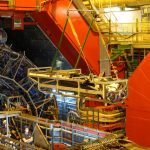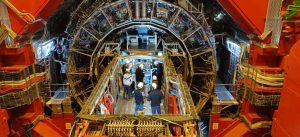 The new Internal Tracking System (ITS) of the ALICE experiment, based on ultra-thin silicon-sensors (50-100 micron), is at CERN since several months for tests and commissioning.
The new Internal Tracking System (ITS) of the ALICE experiment, based on ultra-thin silicon-sensors (50-100 micron), is at CERN since several months for tests and commissioning.
The ITS is a cylindrical detector consisting of 2 sub-structures called Outer and Inner Barrel. Overall, the apparatus counts 7 active concentric layers that allow to track charged particles, produced in the LHC collisions, with a precision of few microns. The realization of this new detector required 3 years of work and a perfect cooperation among 35 institutions in 15 countries. Among these, the Frascati National Laboratory of INFN where the local ALICE group realized 1/4 of the sensitive units of the Outer Barrel. The work took place in a dedicated infrastructure prepared at LNF where the level of dust is controlled and reduced at maximum (clean room). Overall, the new ITS, one of the most technologically advanced component of ALICE, counts about 12.5 gigapixels, 3 of which realized at LNF.
The ITS Outer Barrel left the laboratory located in building 167 at the CERN Meyrin site, on Monday March 15th, at 4 o’clock in the morning, to be transported at its final destination: the heart of the ALICE detector. The transportation, traveling at 20 Km/h, reached, under a heavy snowfall, the ALICE experimental site located 58 m below the ground level. The lower part of the Outer Barrel was the first to be installed at the center of ALICE. The operation took place without mishaps and even a little bit ahead schedule. After this insertion, a series of metrological tests were performed to verify that the operation did not affected mechanically the neighboring detectors, like the GEM-TPC (another major upgrade of ALICE), that surrounds completely the ITS.
The second section of the Outer Barrel (OB-TOP) completing the ITS Outer Barrel was installed on Thursday March the 18th. Now is in preparation the installation of the inner elements that, even if smaller, represent a challenge since they are located closer to the interaction point. At the end of these operations, this jewel of micro-engineering will be ready for the new data acquisition phase that is foreseen this year at the end of September.
“It was a long awaited and very emotional moment” says Federico Ronchetti, the technical coordinator of ITS construction at LNF and now at CERN as Run Coordinator of ALICE for the restart of LHC. “We look forward to turn on the ITS and the other detectors for the first test collisions, with injection energy, scheduled for this year in late September”.
 INFN-LNF Laboratori Nazionali di Frascati
INFN-LNF Laboratori Nazionali di Frascati

